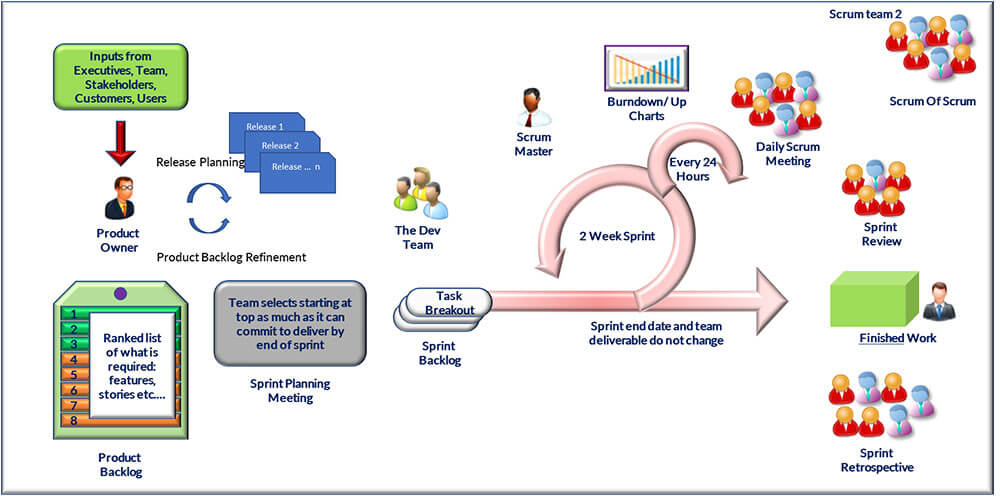This website uses cookies. By continuing to browse the site, you are agreeing to our use of cookies
Agile DevOps Part 3 – The Scrum Framework
Cloud
August 31, 2019
Introduction
Welcome to the world of Agile DevOps! In this blog, we will discuss different scrum events. As we all know, scrum is the most popular Agile framework and can reap great business benefits if executed thoroughly. Thus, understanding its events becomes even more important as it is these events which actually help in collaboration and self-organization of teams and bring value to the efforts. To be precise, conducting scrum events ensures the success of scrum teams.
So, let’s have a quick overview of important scrum events and understand their role in scrum.
Scrum Events
1. Sprint Planning
- Identify stories for the sprint
- Estimate story size
- Identify task/sub-tasks for each story and enter into ALM (Application Lifecycle Management) tool
- Estimate task/sub-tasks in hours
- Team members self-assign stories/ tasks (if not assigned earlier) before the start of the sprint
This event is a 4-hour session per 2-week sprint and happens on the first day of sprint before the sprint begins. Sprint planning is also considered as a ceremony in scrum.
2. Daily Scrum
- Conduct daily
- Limit to 15 minutes
- Each team member to address the following topics:
- What I have completed since the last daily scrum?
- What I plan to complete before the next meeting?
- What are the impediments preventing me from making progress?
- Scrum master flags impediments in ALM
Daily Scrum is also considered as a scrum ceremony.
3. Sprint Review
- Demonstrate functionality of each story as per the agreed upon test cases
- Accept or reject each user story
- Document any technical or functional defects discovered during this process
- Collect and track any feedback for next sprint(s)
- Review deliverables for adherence to predefined definition of done
This event is a 2-hour session for a 2-week sprint and happens on the last day of the sprint. Sprint review is also considered as a ceremony in scrum.
4. Sprint Retrospective
- The team brainstorms the following questions (at least):
- What do we need to stop doing?
- What do we need to keep doing?
- What do we need to start doing?
- Scrumming the scrum – Identify an improvement opportunity with the highest impact potential
This event is a 2-hour session for a 2-week sprint and happens on the last day after the sprint ends. Sprint retrospective is also considered as a scrum ceremony.
5. Backlog Refinement/ Grooming Sessions
- Product owner identifies stories for upcoming sprints
- Product owner discusses the stories with the development team
- The development team estimates story sizes by using planning poker
This event happens throughout the release and is done as and when required. The team should contribute 1-3 hours as required during the sprints.
6. Release Planning
- Product owner is responsible for release planning
- It is an ongoing activity throughout the project and is done based on inputs received from business, product vision, previous releases, sprint planning and daily planning
- Product owner invites other stakeholders including scrum team members for meetings when required
7. Scrum of Scrums
- Scrum teams meet periodically, if not daily, for a formal discussion
- Ambassadors from each scrum team attend the meeting
- Members discuss on dependencies, achievements and future releases
8. Sprint
- During a sprint, team burns the work identified in product backlog
- Team pulls work from product backlog and adds to sprint backlog during sprint planning
- Team tracks its productivity in the form of story points
- Unfinished work is moved back to the product backlog
- Inspect and adapt happens as per decided cadence and covers daily scrum, review and retrospective sessions
Sprint is an important event in itself.
Scrum in a Nutshell
Now, let’s have a look at the scrum framework in Figure 1 given below to understand how scrum process works in a sprint. Actual work is done in a sprint and product increment is obtained as per the committed goals with the help of other scrum events. Inputs are taken from stakeholders and transformed into the product backlog in the form of user stories and tasks by the product owner. Release planning is done by the product owner to plan for the releases and backlog is prioritized accordingly. Product owner holds Backlog Refinement meeting with the scrum team to move from uncertainty to certainty and part of these stories are groomed further, while spikes are identified. Scrum team gets into Sprint Planning and commits to Sprint backlog. Scrum team meets daily as part of Daily Scrum to discuss on the progress of scrum and identify impediments and plan till the next scrum. Team demonstrates the progress and the product owner reviews the progress as part of Sprint Review meeting before the sprint is closed. After sprint is closed, the scrum team gets into retrospective meetings to identify what went well, what could have been done better and what needs improvement. The team accordingly collects the action items and work on it. Scrum of Scrum is conducted after Daily Scrum between different scrum teams to resolve dependencies between teams.

Conclusion
Conducting scrum events improperly or incompletely can derail the entire scrum team and defeat the very purpose of practicing scrum. Scrum events help to drive sprint execution towards committed goal and get the desired product increment. Success of scrum is based on how effectively the scrum team makes use of each scrum event.
About the Author

Suhas Mali
Read more
Related Blogs

Understanding Snowflake Cortex for Gen AI Applications with Sensitive Data
- Data & Analytics
- Generative AI
- Cloud

Ready to Pursue Opportunity?
Every outcome starts with a conversation
















